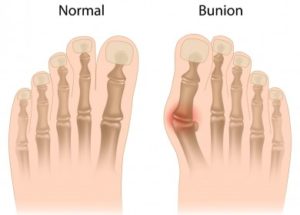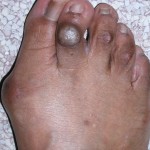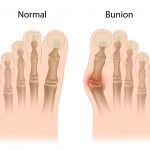What is a Bunion and how to treat bunion pain?
 What is a Bunion?
What is a Bunion?
Bunions (hallux valgus) are described as a bump on the side of the big toe. But a bunion pain is more than that. The visible bump actually reflects changes in the bony framework of the front part of the foot. With a bunion, the big toe leans toward the second toe, rather than pointing straight ahead. This throws the bones out of alignment,  producing the bunion’s “bump.” Bunions are a progressive disorder. They begin with a leaning of the big toe, gradually changing the angle of the bones over the years and slowly producing the characteristic bump, which continues to become increasingly prominent.
producing the bunion’s “bump.” Bunions are a progressive disorder. They begin with a leaning of the big toe, gradually changing the angle of the bones over the years and slowly producing the characteristic bump, which continues to become increasingly prominent.
What Causes a painful Bunion?
- Inherited faulty mechanical structure of the foot
- Wearing shoes that crowd the toes
Symptoms of bunion pain?
Symptoms occur most often when wearing shoes that crowd the toes—shoes with a tight toe box or high heels. This may explain why women are more likely to have symptoms than men. In addition, spending long periods of time on your feet can aggravate the symptoms of bunions. Symptoms, which occur at the site of the bunion, may include:
- Pain or soreness
- Inflammation and redness
- Burning sensation
- Perhaps some numbness
- Calluses on the big toe, sores between the toes, ingrown toenail, and restricted toe motion
Diagnosis of bunion pain
 Bunions are readily apparent–you can see the prominence at the base of the big toe or side of the foot. However, to fully evaluate your condition, the foot and ankle surgeon may take x-rays to determine the degree of the deformity and assess the changes that have occurred. Because bunions are progressive, they don’t go away, and will usually get worse over time. But not all cases are alike some bunions progress more rapidly than others. Once your foot and ankle surgeon has evaluated your particular case, a treatment plan can be developed that is suited to your needs.
Bunions are readily apparent–you can see the prominence at the base of the big toe or side of the foot. However, to fully evaluate your condition, the foot and ankle surgeon may take x-rays to determine the degree of the deformity and assess the changes that have occurred. Because bunions are progressive, they don’t go away, and will usually get worse over time. But not all cases are alike some bunions progress more rapidly than others. Once your foot and ankle surgeon has evaluated your particular case, a treatment plan can be developed that is suited to your needs.
Treatment
Sometimes observation of the
- Changes in shoewear. Wearing the right kind of shoes is very important. Choose shoes that have a wide toe box and forgo those with pointed toes or high heels which may aggravate the condition.
- Padding. Pads placed over the area of the bunion can help minimize pain. You can get bunion pads from your foot and ankle surgeon or purchase them at a drug store.
- Activity modifications. Avoid activity that causes bunion pain, including standing for long periods of time.
- Medications. Nonsteroidal anti-inflammatory drugs (NSAIDs), such as ibuprofen, may help to relieve pain.
- Icing. Applying an ice pack several times a day helps reduce inflammation and pain.
- Injection therapy. Although rarely used in bunion treatment, injections of corticosteroids may be useful in treating the inflamed bursa (fluid-filled sac located in a joint) sometimes seen with bunions.
- Orthotic devices. In some cases, custom orthotic devices may be provided by the foot and ankle surgeon.
When is Surgery Needed?
 When the pain of a bunion interferes with daily activities, it’s time to discuss surgical options with your foot and ankle surgeon. Together you can decide if surgery is best for you. Most of the time conservative treatment does not help alleviate bunion pain or the deformity. Recent advances in surgical techniques have led to a very high success rate in treating bunions. A variety of surgical procedures are performed to treat bunions. One type of surgery is called a SCARF procedure. The procedures are designed to remove the “bump” of bone, correct the changes in the bony structure of the foot, as well as correct soft tissue changes that may also have occurred. The goal of these corrections is the elimination of pain. In selecting the procedure or combination of procedures for your particular case, the surgeon will take into consideration the extent of your deformity based on the x-ray findings, your age, your activity level, and other factors. The length of the recovery period will vary, depending on the procedure or procedures performed.
When the pain of a bunion interferes with daily activities, it’s time to discuss surgical options with your foot and ankle surgeon. Together you can decide if surgery is best for you. Most of the time conservative treatment does not help alleviate bunion pain or the deformity. Recent advances in surgical techniques have led to a very high success rate in treating bunions. A variety of surgical procedures are performed to treat bunions. One type of surgery is called a SCARF procedure. The procedures are designed to remove the “bump” of bone, correct the changes in the bony structure of the foot, as well as correct soft tissue changes that may also have occurred. The goal of these corrections is the elimination of pain. In selecting the procedure or combination of procedures for your particular case, the surgeon will take into consideration the extent of your deformity based on the x-ray findings, your age, your activity level, and other factors. The length of the recovery period will vary, depending on the procedure or procedures performed.
Most typical bunionectomy procedures will need about 4-6 weeks off work or light duties then additional 2-4 weeks for complete healing. Some swelling will continue with some patients for up to
Coming soon: Click here to see a timeline of what to expect from a typical bunionectomy procedure and the time it takes from pre-operative to post-operative and full recovery.
Accepted Insurance Plans
Health insurance plans in Missouri that Arch City Foot & Ankle are contracted to:
- United Health Care
- Blue Cross and Blue Shield
- Anthem BCBS
- Medicare
- Medicaid
- Railroad Medicare
- Cigna
- Aetna
- GHP
- Advantra
- Mercy
- Healthlink
- Healthcare USA
Please contact the office if your insurance plan is not listed above.
